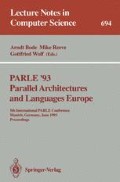Abstract
The fundamental model of memory requires each read to an address to return the most recent value written to the same address. This model becomes a consistency requirement for parallel shared memory machines, and is taken as a necessary property for correct algorithm execution. In Distributed Shared Memory (DSM) systems the presence of processor memory caches means that the processors may develop historical and therefore different views of the distributed memory. The paper examines the relationship between synchronisation and consistency, proposes that synchronisation should enforce consistency, and examines the consequences using barriers as an example. A typical shared memory MIMD program is shown to execute correctly without normal consistency, and the experiment suggests that the relationship between synchronisation and consistency bears further investigation.
Preview
Unable to display preview. Download preview PDF.
References
M. Dubois, and C. Scheurich, “Memory Access Dependencies in Shared-Memory Multiprocessors”, Dept. of Elec. Eng., Univ. of Southern California, Los Angeles, CA, IEEE Trans. on Software Eng., Vol. 16, No. 6, June 1990, pp. 660–673.
R.S. Francis, I.D. Mathieson, and A.N. Pears, “Compiler Integrated Multiprocessor Simulation”, Int. J. in Comp. Sim., Vol 1, No 2, pp. 169–188, 1991.
B. Nitzberg, and V. Lo, “Distributed Shared Memory: A Survey of Issues and Algorithms”, IEEE Comp., Aug 1991, pp. 52–60.
A.N. PEARS, and R.S. FRANCIS, “How Much Consistency is a Good Thing?”, Proc. of the Aust. Comp. Sci. Conf. ACSC-16, Brisbane. Aust., Feb 3–5, 1993.
A.N. PEARS, and R.S. FRANCIS, “Execution Driven Multicomputer Simulation: The DiST Experience.”, 2nd Int. Conf. on Modelling and Simulation, Melb. Aust., July 12–14, 1993, To Appear.
R. SADOURNY, “The Dynamics of Finite-Difference Models of the Shallow Water Equations”, Journal of Atmos. Sci., Vol 32, 1975, pp. 680–689.
A.V. Veidenbaum, “A Compiler-Assisted Cache Coherence Solution for Multiprocessors”, Proc of ICPP, 1986, pp. 1029–1036.
Author information
Authors and Affiliations
Editor information
Rights and permissions
Copyright information
© 1993 Springer-Verlag Berlin Heidelberg
About this paper
Cite this paper
Pears, A., Francis, R. (1993). Barrier semantics in very weak memory. In: Bode, A., Reeve, M., Wolf, G. (eds) PARLE '93 Parallel Architectures and Languages Europe. PARLE 1993. Lecture Notes in Computer Science, vol 694. Springer, Berlin, Heidelberg. https://doi.org/10.1007/3-540-56891-3_70
Download citation
DOI: https://doi.org/10.1007/3-540-56891-3_70
Published:
Publisher Name: Springer, Berlin, Heidelberg
Print ISBN: 978-3-540-56891-9
Online ISBN: 978-3-540-47779-2
eBook Packages: Springer Book Archive

